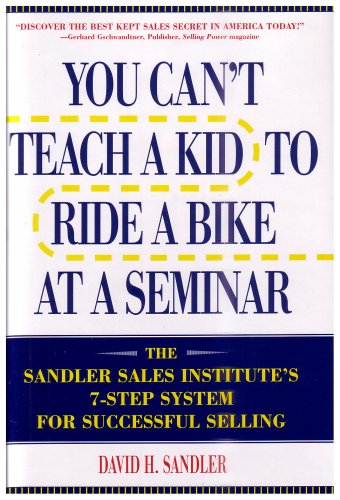Why did I chose this resource?
I was gifted this book from one of our team members and it’s the last book David Sandler wrote before he passed away. It encompasses the Sandler Selling Technique in one place.
What did you learn from it?
Prospects lie. They manipulate sales people. Selling doesn’t have to to be difficult. Prospects want to maintain control. We as sales people can maintain control and let the prospect think they have control. The Sandler Submarine outlines a sales process that should be “Run Silent. Run Deep.”
Key Knowledge
- Five Rules for Success
- 1. Qualify your prospects
- 2. Extract your prospect’s “pain”
- 3. Verify that the prospect has money
- 4. Be sure the prospect is a decision maker
- 5. Match your service or product to the prospect’s “pain”
- The Sandler Submarine: 7 Step Process
- 1. Bonding & Rapport. Make the prospect feel more okay than you feel. This should be genuine and authentic. Authentic rapport will mean a lasting client relationship.
- 2. Up-front Contracts. Create an agreement to see if you have anything to discuss. Always begin every conversation with a simple “agenda.” “I’d like to see if you want to go forward with the project. If not, it’s okay. I just want to make sure that we’re maximizing each others’ time.”
- 3. Pain. Find a prospect’s “hurt” and probe how much pain they are in. Show how your business can eliminate the pain. Sometimes they will tell you without you asking. It’s good clarify it and identify in so that they feel, that you feel their pain as well. “We had another client with the same problem. It was a disaster before we helped them out. I know where you are.”
- 4. Budget. Identify their budget, or offer a lower end “entry” solution. We do this with our “Discovery” phase to get clients in the door if they don’t have an idea of their budget. It’s still good to understand the time and money budget: How much can they spend by when?
- 5. Decision. What is your prospect’s decision-making process? When will they be moving forward? How do you get paid? Who will be involved the the decision-making process? This goes along with other books of finding the relevant decision maker. It’s okay to ask “Are you the person making the decision on this project?”
- 6. Fulfillment. Review your prospect’s contract, pain, budget, and decisions. Ensure that your solution solves the prospect’s pain. This is when we verify the line item with our customers and sometimes we give a “presentation.”
- 7. Post-Sell. To avoid buyer’s remorse, thank them for the order, bring up a agreed upon compromise, and give them a chance to back out now. Our post sell is after the MSA. It means they have agreed to work with us and that they can walk away without approving more work. If they want to start the project, they can make the payment and move forward. Otherwise they risk not being able to work with us by not paying.
How are you using what you learned?
I have been applying the Sandler submarine on every sales call now, and have adapted the 7 steps to our 4 milestone process. The 7 steps can be done as a strategy across all of our milestones, but they can be also applied during individual sales calls. Each sales call is a “sale.” In our sales conversations , we always get the customer to “buy” by signing something and moving to the next mini-sale.
Key Changes
- I “shoot the shit” for a few minutes.
- I explain the outcome of the meeting and it’s usually three things. (Outline, Discussion, Decision)
- I wait for them to ask about next actions after I affirm their decisions.
- I then ask them if they want to move forward and then I give them the rundown of our contracts. ( NDA, MSA, Project Charter)
- I say “We don’t do what you tell us to, we do what is right for you. Is that okay with you?”
How can we as a company or individuals in the company use this?
Everyone should be familiar with our sales process and at the very least understand how to make the first mini-sale, which is before our “Qualify” phase. It is to harvest someone’s information with their permission to put into our lead system. “Do you mind if I have your card so that I can contact you later about potentially working with you?” or “Our company’s CEO is always looking to connect with other entrepreneurs because he’s writing a book, do you mind if I give him your information?” Beyond that everyone should understand the sales process to at least tell someone who asks “Do you guys make websites, and if so, how much?” that “We’re a professional internet architecture firm and we can help you do that but we would need to understand exactly what you are trying to do during a discovery phase in our process.”
Key Actions
- Send a “Project Kickoff & Thank You” Email to all those responsible for making a sale happen.
- Ask during the first conversation if the person is responsible for making the logistics and financial decisions.
- Continue to explain our process and announce the agenda for each call.
- Document the sales processes as a set of mini-sales.
- Explain to prospects at any time that it’s okay to not move forward.
- Explain to prospects that we may not be the right fit.
Source
- Name : You can’t teach a kid to bike at a seminar.
- Author : David Sandler
- Physical Book : in DC
- Article: Summary
- Article: Book Review
- Sample Chapter: Chapter 5 : Break the rules and close more sales


